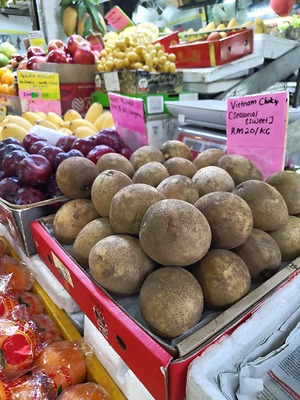


Chikoo
Estimated Inventory, lb : 0
Description/Taste
Chikoo is an egg-shaped tropical fruit that grows on trees that can reach up to 30 meters in height. Its oval shape bears a resemblance to a kiwi, accented by slightly pointed ends, a light brown hue, and fuzzy brown skin. Ranging from 5 to 9 centimeters in diameter, it mirrors the dimensions of a small potato. Chikoo has translucent yellowish-orange flesh that’s both juicy and subtly grainy, harboring 2 to 5 shiny black seeds. The fruit emits a sweet and slightly malty fragrance that blends notes of pear, brown sugar, and occasionally a whisper of vanilla. Chikoo presents a bitter and astringent taste in its unripe state, evoking a dry, puckering sensation akin to an unripe persimmon or black sapote. When ripe, Chikoo becomes sweet like a pear, with a strong, malty flavor similar to molasses.
Seasons/Availability
Chikoo is available from late winter to fall, with peak availability usually occurring in midsummer.
Current Facts
Chikoo, scientifically known as Manilkara zapota, is a member of the genus Manilkara. It’s globally recognized by various names: Sapodilla in English, Naseberry in the British West Indies, Chicozapote in Mexico, Sapotillier in the French West Indies, and Dilly in the Bahamas. Originating from Central America, the Chikoo tree is an evergreen species cultivated since ancient times. The tree's milky latex served as a traditional chewing gum among the Aztecs. Chikoo wood has been used to create intricately carved lintels that are over a thousand years old and can still be seen in some Mayan ruins. The fruit is closely related to mamey sapote and canistel fruit, sharing a similar botanical family. In the wild, Chikoo naturally spreads when mammals like raccoons and opossums consume the fruit and disperse the seeds, fostering the growth of new trees.
Nutritional Value
Chikoo is rich in vitamin C, essential for bodily functions such as collagen production and immune support. It is a significant source of copper, which plays a key role in creating new blood cells, brain development, and immune health. Compared to other fruits such as durian, guava, apple, Chinese pear, and star fruit, Chikoo contains a higher fiber content, which may contribute to digestive and heart health. Various parts of the Chikoo tree, including the leaves, bark, and fruit, have been integral in traditional medicine to alleviate fever, diarrhea, coughs, colds, ulcers, and arthritis. In Ayurvedic medicine, Chikoo is valued for its anti-inflammatory properties. The natural tannins found in the flesh of the fruit act as antioxidants, offering antiviral, antibacterial, and anti-parasitic benefits.
Applications
The flesh and juice of the Chikoo fruit are edible, but its seeds and skin should not be consumed. The seeds are notably hard and feature a hook-like end that can be a choking hazard if swallowed. Chikoo is commonly enjoyed fresh, either by itself or blended into smoothies. In Latin America, it’s popularly used in fruity milkshakes called batidos. Chikoo can be used in a variety of desserts, including pies, crumbles, jams, custards, ice creams, and sherbets. Incorporating scooped Chikoo flesh into green salads or mixing it into egg custard for baking adds a unique flavor. Chikoo can be made into a sauce by pressing the pulp through a strainer and combining it with juice. Chikoo continues to ripen after being harvested and is highly perishable, so it's best to refrigerate and consume within a week. For longer storage, the flesh can be frozen in chunks and used over several months.
Ethnic/Cultural Info
The ancient Mayas and Aztecs pioneered the creation of the first chewing gum by boiling the 'chicle' sap extracted from Chikoo trees. They would then mold this sap into large blocks, from which they cut small pieces to chew. This traditional practice laid the groundwork for modern chewing gum. In 1866, General Santa Anna, a former Mexican president, introduced chicle sap to a businessman in New York who combined the chicle with sugar, thus inventing a new type of chewing gum. On India's western coast, the areas of Dahanu and Gholvad are celebrated for their lush Chikoo orchards. Dahanu hosts a yearly Chikoo Festival, attracting tourists and tropical fruit enthusiasts from various regions to celebrate the fruit.
Geography/History
Chikoo is native to Mexico's Yucatan Peninsula and has a long history of cultivation across Central America. It has found its way to the West Indies, Bermuda, Southern Asia, Florida, and Hawaii. India stands out as one of the largest producers of Chikoo, while in Mexico, the tree is primarily cultivated for the extraction of chicle from its bark. Thriving in sunny, tropical, and subtropical climates, Chikoo was introduced to the Philippines by Spanish colonists, leading to its rapid spread across tropical Asia. Although Chikoo might be less known to many in the United States, it enjoys popularity in regions like South Florida and Hawaii, where it's a sought-after item at farmers' markets. Despite limited availability outside its growing regions, Chikoo is occasionally shipped to international specialty stores.
Recipe Ideas
Recipes that include Chikoo. One
| Tickling Palates |
|
Chikoo Milkshake |
| The Familiar Kitchen |
|
Chikoo Sticky Buns |
| Whisk Affair |
|
Chikoo Kheer |
| Out of the Ordinary |
|
Chikoo Mousse |

















